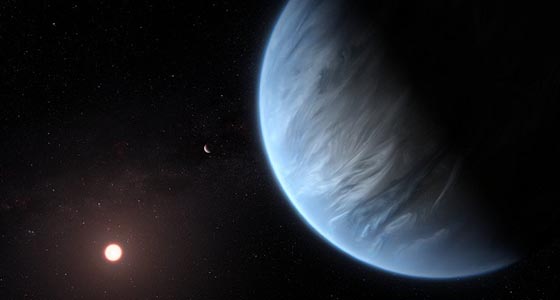Scientists May Detect Signs of Extraterrestrial Life in the Next 5 to 10 Years
Telescope launching this autumn could spot biosignatures on other planets within three days
Press conference: 12:00 p.m. CDT, Sunday, April 18, 2021

An artistic impression of one of the exoplanets in the study, K2-18b. The image shows the planet, its host star, and an accompanying planet in this system. K2-18b is now the only gas dwarf exoplanet known to host both water and temperatures that could support life. Credit: ESA / Hubble, M. Kornmesser, CC BY 4.0
Research shows that a new telescope could detect a potential signature of life on other planets in as little as 60 hours.
“What really surprised me about the results is that we may realistically find signs of life on other planets in the next 5 to 10 years,” said Caprice Phillips, a graduate student at The Ohio State University, who will share preliminary findings at a press conference during the 2021 APS April Meeting.
Gas dwarf planets have the potential to foster life. But because none of these super-Earths or mini-Neptunes exist within our solar system, scientists struggle to determine whether their atmospheres contain ammonia and other potential signs of living things.
Phillips calculated that when the James Webb Space Telescope launches this October, it could feasibly detect ammonia around six gas dwarf planets after just a few orbits.
She and her team modeled how JWST instruments would respond to varying clouds and atmospheric conditions, then produced a ranked list of where the telescope should search for life.
“Humankind has contemplated the questions, ‘Are we alone? What is life? Is life elsewhere similar to us?’” said Phillips. “My research suggests that for the first time, we have the scientific knowledge and technological capabilities to realistically begin to find the answers to these questions.”
FEATURED TALK
Detecting Biosignatures in the Atmospheres of Gas Dwarfs With JWST (K05.2)
2:06 p.m. - 2:42 p.m. CDT, Sunday, April 18, 2021
Caprice Phillips, phillips.1622@buckeyemail.osu.edu
Livestream: Access here
Abstract: https://meetings.aps.org/Meeting/APR21/Session/K05.2
PRESS CONFERENCE
Register for the press conference to be held on Zoom at 12:00 p.m. CDT, Sunday, April 18, 2021.
Speaker:
- Caprice Phillips (Ohio State)
Press Conference Schedule
Register for each press conference separately at the links below. Press conferences will be recorded and made available upon request.
Saturday, April 17
10:00 a.m. CDT Measuring Neutron Star Squeezability
NICER collaboration, NASA astronaut reveal size of most massive neutron star, highlight Space Station science
Register
12:00 p.m. CDT On the Pulse of Pulsars and Polar Light
Reimagined telescopes may fill the void left by Arecibo’s collapse
Register
Sunday, April 18
10:00 a.m. CDT The Future of Particle Accelerators Is Here
Behind the scenes of the Electron-Ion Collider, green accelerators that waste no energy, and chiral magnetic effect results debuting this summer
Register
12:00 p.m. CDT Scientists May Detect Signs of Extraterrestrial Life in the Next 5 to 10 Years
Telescope launching this autumn could spot biosignatures on other planets within three days
Register
Monday, April 19
11:00 a.m. CDT The Fate of the Planet
Unconventional takes on pandemics and nuclear defense could protect humanity from catastrophic failure
Register
